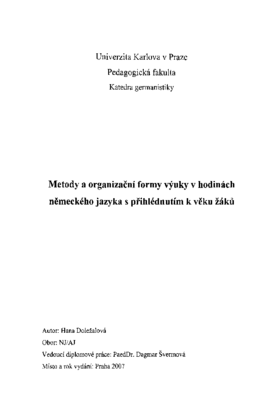Metody a organizační formy výuky v hodinách německého jazyka s přihlédnutím k věku žáků
Teaching methods and class organisation in German language teaching with reference to pupil's age
diplomová práce (OBHÁJENO)

Zobrazit/
Trvalý odkaz
http://hdl.handle.net/20.500.11956/12085Identifikátory
SIS: 53481
Kolekce
- Kvalifikační práce [19087]
Autor
Vedoucí práce
Oponent práce
Nečasová, Pavla
Fakulta / součást
Pedagogická fakulta
Obor
Učitelství všeobecně vzdělávacích předmětů pro základní školy a střední školy anglický jazyk - německý jazyk
Katedra / ústav / klinika
Katedra germanistiky
Datum obhajoby
21. 1. 2008
Nakladatel
Univerzita Karlova, Pedagogická fakultaJazyk
Čeština
Známka
Velmi dobře
Diplomová práce se zabývá problematikou výukových metod a organizačních forem výuky s přihlédnutím k věku žáků. V první části je uvedena základní charakteristika psychického a tělesného vývoje žáků, klasifikace a charakteristika vybraných výukových metod a organizační formy vyučování a v neposlední řade typologie cvičení. V druhé, prakticky zaměřené části jsou uvedeny metody a organizační formy výuky, jež vyučující v hodinách německého jazyka nejběžněji využívají spolu s přihlédnutím k věku žáků jako jednoho z faktorů, jez ovlivňuje výběr těchto metod a forem. V příloze najdeme dva vzory pozorovacích archů, dotazník a hospitační záznamy spolu s ukázkami učebních materiálů, ktere vyučující používali ve svých hodinách.
The Diploma Thesis deals with teacbing methods and classroom organisation in Gennan language teaching with reference to pupil's age. The first, theoretical-oriented part of the Thesis describes psychological and physical development of pupils~ classification and description of selected teaching methods and types of classroom organisation. Last but not least it contains the typology ofexercises for teaching purposes. The second, practice-oriented part maps teaching methods and types of classroom organisation commonly used in German language teaching with reference to pupil's age which is regarded as one of the fuctors influencing the choice of teaching methods and classroom organisation. Two classroom observation templates, a questionnaire and some samples of filled observations sheets along with teaching materials used by teachers during the 1essons are attached in appendices.
